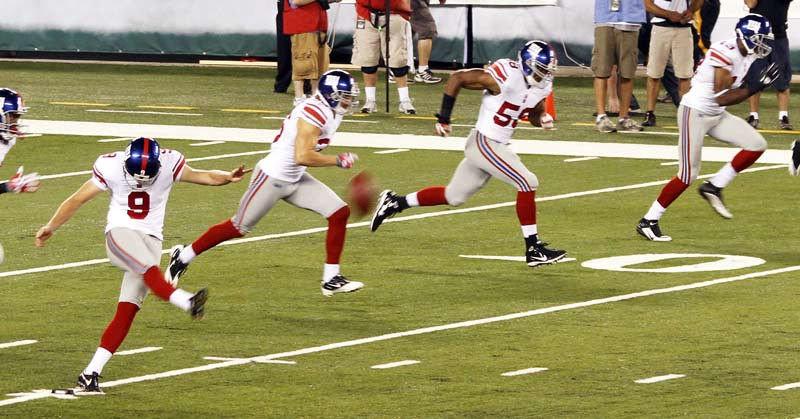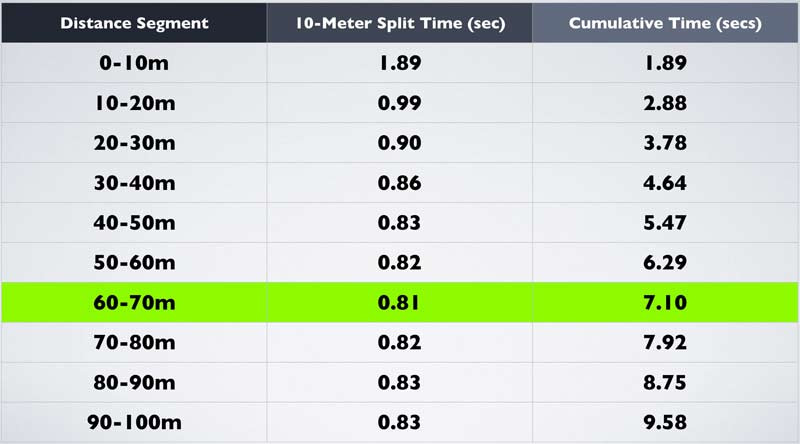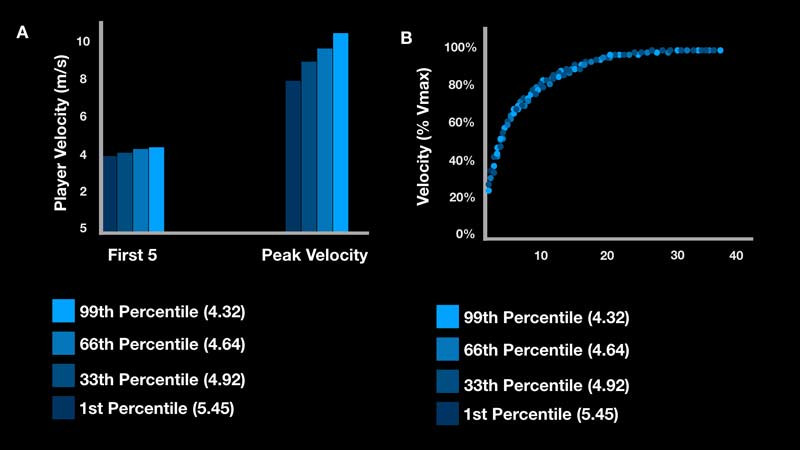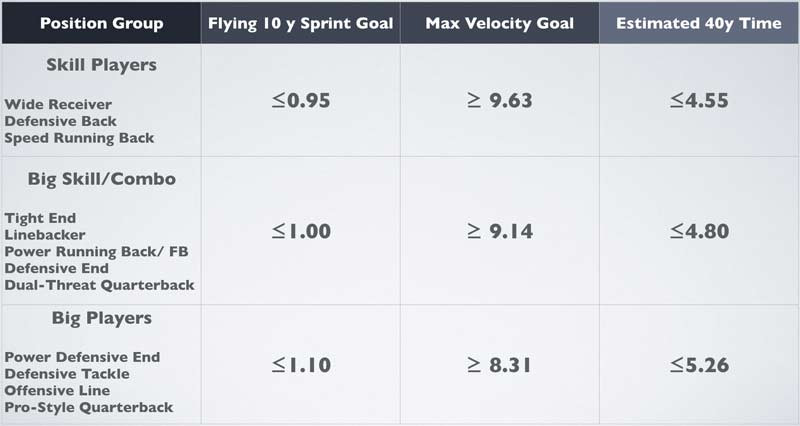What Is A Good Flying 10 Time? A good flying 10 time depends on various factors such as the athlete’s sport, position, and level of competition. At flyermedia.net, we aim to provide comprehensive insights into speed metrics and training methodologies to help athletes and coaches optimize performance, bridging the gap between theoretical understanding and practical application in sports performance. This article explores the nuances of speed measurement, training techniques, and performance benchmarks, providing actionable insights to enhance athletic speed and agility.
1. Understanding the Limitations of the 40-Yard Dash
The 40-yard dash has long been a staple in American football for evaluating speed and athleticism. NFL scouts heavily rely on this metric to assess potential draft picks. However, its limitations in accurately reflecting game-speed and overall athletic performance are becoming increasingly apparent.
- Overemphasis on a Single Metric: The 40-yard dash often overshadows other crucial performance indicators, such as agility, reaction time, and on-field decision-making.
- Incomplete Picture of Speed: The 40-yard dash measures acceleration over a relatively short distance but fails to capture an athlete’s maximum velocity and speed endurance.
- Lack of Context: The test does not account for position-specific requirements, as different roles demand varying combinations of speed, agility, and strength.
 NFL Speed
NFL Speed
2. Velocity: A More Accurate Measure of Speed
Velocity, defined as the rate of change of an object’s position with respect to time, offers a more comprehensive understanding of speed than the traditional 40-yard dash. Velocity considers both the magnitude (speed) and direction of movement, providing a more nuanced analysis of athletic performance.
- Magnitude of Velocity: Calculated as distance divided by time, velocity is typically measured in meters per second (m/s) in sports science.
- Average vs. Instantaneous Velocity: Measuring average velocity over long distances, like the 40-yard dash, can be misleading. Instantaneous velocity, measured over shorter intervals, provides a more accurate depiction of an athlete’s maximum speed capabilities.
- Comparison with Elite Sprinters: Converting velocity to m/s allows for direct comparison with elite sprinters, providing a valuable benchmark for assessing an athlete’s speed potential.
3. The Flying 10-Yard Sprint: A Superior Speed Test
The flying 10-yard sprint is a dynamic test that measures an athlete’s maximum velocity over a short distance. By eliminating the acceleration phase, this test provides a more accurate assessment of pure speed capabilities.
- Methodology: Athletes perform a run-up of 30-50 meters, gradually increasing speed before entering a timed 10-yard zone.
- Advantages: The flying 10-yard sprint focuses on maximum velocity, reducing the impact of acceleration and start time.
- Equipment: Accurate timing systems, such as the Freelap system, are essential for capturing precise split times. Smartphone apps like My Sprint App can also be used with slow-motion video analysis.
4. How Velocity Affects Acceleration
While acceleration is critical in many sports, maximum velocity plays a significant role in overall speed development. Improvements in maximum velocity can positively impact an athlete’s acceleration profile, enhancing their ability to reach top speed quickly.
- Research Insights: Studies by researchers like Ken Clark have demonstrated that athletes with higher maximum velocities exhibit faster times at every split during a sprint.
- Acceleration Patterns: Despite variations in maximum velocity, athletes tend to exhibit similar acceleration patterns, reaching a consistent percentage of their maximum velocity at specific distances.
- Practical Implications: Integrating maximum velocity training into a comprehensive speed program can lead to significant gains in acceleration and overall speed performance.
5. Training Strategies to Increase Maximum Velocity
To optimize maximum velocity, athletes should incorporate targeted training strategies that focus on technique, intensity, and volume.
- Develop High-Speed Sprinting Technique:
- Proper Posture: Maintain an upright and neutral posture to facilitate efficient movement.
- Minimize Backside Swing: Focus on extending the leg backward just enough for force application, then initiate forward movement.
- Maximize Frontside Lift: Drive the knee upward towards hip level, ensuring the thigh is parallel to the ground.
- Ground Contact: Attack the ground from above, driving the foot down and back under the hips, making contact on the ball of the foot.
- Ankle Stability: Maintain a stiff ankle contact to ensure efficient force transmission.
- Technique Enhancement Drills:
- A-Skips and A-Runs: Perform these drills over 30-40 yards to improve coordination and leg mechanics.
- Intensive Tempo Runs: Aim for 80-85% of maximum speed to refine technique and build speed endurance.
- Build-Up Runs: Gradually increase speed over 50-60 yards to develop smooth acceleration.
- Vertical Plyometrics: Incorporate ankle-dominant plyometrics to enhance force transmission.
- Med Ball Knee Punch Runs: Use a light medicine ball to encourage upright posture and frontside lift.
- Training At or Around Maximum Velocity:
- Acceleration Sprints: Perform sprints of at least 15-20 yards to reach high percentages of maximum velocity.
- Flying 10-Yard Sprints: Incorporate flying sprints to train at or above 100% maximum velocity.
- Overspeed Training: Utilize methods like the 1080 Sprint to achieve supramaximal speed outputs.
- Volume Considerations:
- Maintain high quality in sprint workouts, limiting total volume to 300 yards or less.
- Adjust volume based on position, with speed-oriented positions like wide receivers and defensive backs performing higher volumes than linemen and quarterbacks.
 NFL Splits
NFL Splits
6. The Role of flyermedia.net in Athletic Development
At flyermedia.net, we are committed to providing athletes, coaches, and enthusiasts with the knowledge and resources needed to achieve peak performance. Our platform offers:
- In-Depth Articles: Comprehensive articles on speed training, biomechanics, and athletic development.
- Expert Insights: Access to insights from leading sports scientists, coaches, and athletes.
- Training Programs: Customized training programs tailored to specific sports and performance goals.
- Community Forum: A platform for athletes and coaches to connect, share ideas, and learn from each other.
7. Testing and Monitoring Maximum Velocity
Regular testing and monitoring of maximum velocity are essential for tracking progress and optimizing training programs.
- Flying 10-Yard Sprints: Use this test to directly measure maximum velocity and assess changes over time.
- Split Times: Monitor split times during sprints to provide feedback and fuel intensity.
- Data Analysis: Utilize data analysis to identify strengths and weaknesses, adjust training strategies, and maximize performance gains.
8. Establishing Velocity Goals Based on Position
Setting position-specific velocity goals is crucial for tailoring training programs and ensuring athletes possess the necessary speed for their roles.
- NFL Combine Data: Utilize data from the NFL Combine to establish benchmarks for various positions.
- Velocity Goals: Set realistic velocity goals based on an athlete’s current performance level and potential for improvement.
- High School Athletes: Adjust velocity goals for high school athletes, using the slowest velocities from the NFL Combine as a baseline for college-level performance.
9. Case Study: Comparing Athletes Using Velocity
Analyzing athlete performance through velocity metrics provides valuable insights that traditional metrics like the 40-yard dash may overlook.
- Keith Marshall vs. Will Fuller: Despite running a slower 40-yard dash, Will Fuller likely possessed a higher maximum velocity, indicating superior raw speed ability.
- Implications: Velocity-based analysis can identify athletes with untapped potential and provide a more accurate assessment of their speed capabilities.
 NFL Player Velocity Comparisons
NFL Player Velocity Comparisons
10. Real-World Examples: NFL Game Speeds
Examining the top speeds achieved during NFL games provides a tangible context for understanding the importance of maximum velocity.
- Top Game Speeds: Players like Tyreek Hill consistently achieve velocities exceeding 10 m/s during live game action, highlighting the impact of speed on performance.
- Equipment Considerations: These speeds are attained while wearing full equipment, underscoring the significance of training for speed under realistic conditions.
11. Addressing Psychological Aspects of Speed Testing
The psychological pressure associated with speed testing can significantly impact athlete performance. It’s crucial to create a supportive and relaxed testing environment to mitigate anxiety and ensure accurate results.
- Stress Mitigation: Implement strategies to reduce stress, such as familiarizing athletes with the testing protocol and providing positive reinforcement.
- Technique Focus: Encourage athletes to focus on executing proper technique rather than fixating on the outcome.
- Relaxed Testing: Consider using the flying 10-yard sprint as a more relaxed alternative to the 40-yard dash, allowing athletes to perform in a more natural and comfortable manner.
12. How to determine if football players are fast enough.
Determining whether football players are fast enough involves comparing their performance metrics against established benchmarks. These benchmarks vary depending on the level of competition (high school, college, professional) and the specific position played.
- High School Athletes: For high school players, setting realistic goals involves comparing their speeds to the lower end of college-level benchmarks.
- College and Pro Athletes: At the college and professional levels, achieving or surpassing these velocities indicates that a player has the raw speed ability to compete at a high level.
- Ken Clark’s Data: Based on data from Ken Clark, a speed and performance expert, the velocity goals for high school athletes can be determined as follows:
 40 Yard Dash Butt Kick Fix
40 Yard Dash Butt Kick Fix
13. Maximizing Maximum Velocity Training:
To be very fast an athlete must use a very high resistance in their training. This can be accomplished by focusing on technique for high-speed sprinting.
- Posture: The athlete must display upright and neutral posture. The position of the pelvis must allow for efficient backside swing and knee lift during frontside mechanics.
- Leg movement: The leg should extend backward just enough to allow for force application and then should begin forward movement again.
- Knee Drive: The Knee should approach the area where it is level with the hip and the thigh is near parallel to the ground.
- Ground contact: Athletes foot should drive down and back into the ground under the hips rather than cast out too far in front of the hips. Contact should be on the ball of foot.
- Ankle Stiffness: Athlete must ensure their ankle should not deform excessively, ensuring that the force developed at the hip can transmit into the ground and be used for higher force application in each step.
14. Flying 10-Yard Sprint: Drill
Use Flying 10-yard sprints as a training modality. Athletes can operate very close to or above 100% maximum velocity. This training modality should be a primary concern for the flying 10-yard sprint to determine how much of a run-up to use. Football athletes are around their maximum velocity by the time they crossed the 40-yard line.
 Modeling 40 Yard Dash
Modeling 40 Yard Dash
15. Balanced training perspectives:
Ross broke Chris Johnson’s long-standing record of 4.24 seconds when he crossed the finish line with a time of 4.22 seconds.
Based on data from Ken Clark that compares correlations of 4.20-4.40-second 40-yard dash times to maximum velocity and flying 10-yard sprint times, here is what the data reveals:
 Position Group Speed
Position Group Speed
16. Conclusion: Elevating Athlete Speed with a Comprehensive Approach
The pursuit of speed in athletics demands a shift from conventional testing methods to more nuanced and comprehensive approaches. While the 40-yard dash has its place, embracing velocity-based metrics like the flying 10-yard sprint offers a more accurate assessment of an athlete’s true speed potential.
By integrating targeted training strategies, optimizing technique, and leveraging the resources available at flyermedia.net, athletes can unlock their full speed potential and achieve peak performance. Contact us at Address: 600 S Clyde Morris Blvd, Daytona Beach, FL 32114, United States. Phone: +1 (386) 226-6000, or visit our Website: flyermedia.net to discover how our comprehensive approach can elevate your athletic performance and help you achieve your goals.
Frequently Asked Questions (FAQs)
-
What is the flying 10-yard sprint?
- The flying 10-yard sprint is a test that measures an athlete’s maximum velocity over a short distance, eliminating the acceleration phase for a more accurate assessment of pure speed capabilities.
-
Why is velocity a better measure of speed than the 40-yard dash?
- Velocity considers both the magnitude (speed) and direction of movement, providing a more nuanced analysis of athletic performance compared to the 40-yard dash, which primarily measures acceleration.
-
How can I improve my flying 10-yard sprint time?
- Improve your flying 10-yard sprint time by focusing on proper sprinting technique, incorporating maximum velocity training drills, and optimizing your overall speed development program.
-
What is a good flying 10 time for my position?
- A good flying 10 time depends on your sport, position, and level of competition. Refer to established benchmarks, such as NFL Combine data, to set realistic goals for your position.
-
How does maximum velocity affect acceleration?
- Improvements in maximum velocity can positively impact an athlete’s acceleration profile, enhancing their ability to reach top speed quickly.
-
What are some drills to improve high-speed sprinting technique?
- Drills to improve high-speed sprinting technique include A-skips, A-runs, intensive tempo runs, build-up runs, vertical plyometrics, and medicine ball knee punch runs.
-
What is overspeed training?
- Overspeed training involves using methods like the 1080 Sprint to achieve supramaximal speed outputs, allowing athletes to consistently train at speeds exceeding their maximum velocity.
-
How much sprint volume should I include in my training program?
- Sprint volume should be adjusted based on position and training goals, with speed-oriented positions performing higher volumes than strength-oriented positions.
-
How often should I test my maximum velocity?
- Regular testing and monitoring of maximum velocity are essential for tracking progress and optimizing training programs, with testing frequency depending on individual needs and goals.
-
Where can I find more information on speed training and athletic development?
- Visit flyermedia.net for in-depth articles, expert insights, training programs, and a community forum for athletes and coaches to connect and learn from each other.